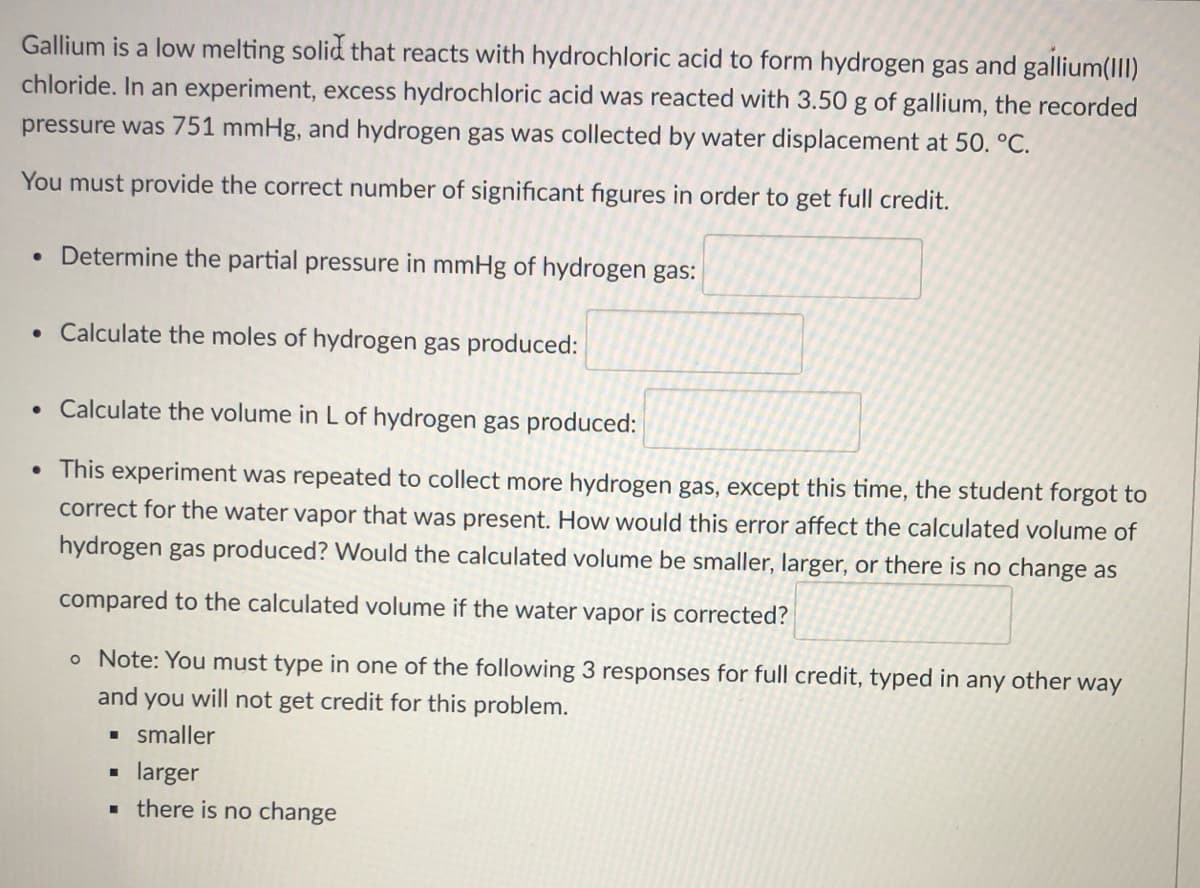Gallium is a low melting solid that reacts with hydrochloric acid to form hydrogen gas and gallium(III) chloride. In an experiment, excess hydrochloric acid was reacted with 3.50 g of gallium, the recorded pressure was 751 mmHg, and hydrogen gas was collected by water displacement at 50. °C. You must provide the correct number of significant figures in order to get full credit. • Determine the partial pressure in mmHg of hydrogen gas: • Calculate the moles of hydrogen gas produced: • Calculate the volume in L of hydrogen gas produced: • This experiment was repeated to collect more hydrogen gas, except this time, the student forgot to correct for the water vapor that was present. How would this error affect the calculated volume of hydrogen gas produced? Would the calculated volume be smaller, larger, or there is no change as compared to the calculated volume if the water vapor is corrected? o Note: You must type in one of the following 3 responses for full credit, typed in any other way and you will not get credit for this problem. - smaller larger - there is no change
Gallium is a low melting solid that reacts with hydrochloric acid to form hydrogen gas and gallium(III) chloride. In an experiment, excess hydrochloric acid was reacted with 3.50 g of gallium, the recorded pressure was 751 mmHg, and hydrogen gas was collected by water displacement at 50. °C. You must provide the correct number of significant figures in order to get full credit. • Determine the partial pressure in mmHg of hydrogen gas: • Calculate the moles of hydrogen gas produced: • Calculate the volume in L of hydrogen gas produced: • This experiment was repeated to collect more hydrogen gas, except this time, the student forgot to correct for the water vapor that was present. How would this error affect the calculated volume of hydrogen gas produced? Would the calculated volume be smaller, larger, or there is no change as compared to the calculated volume if the water vapor is corrected? o Note: You must type in one of the following 3 responses for full credit, typed in any other way and you will not get credit for this problem. - smaller larger - there is no change
Chemistry for Engineering Students
4th Edition
ISBN:9781337398909
Author:Lawrence S. Brown, Tom Holme
Publisher:Lawrence S. Brown, Tom Holme
Chapter5: Gases
Section: Chapter Questions
Problem 5.97PAE: 97 Homes in rural areas where natural gas service is not available often rely on propane to fuel...
Related questions
Question
Answer ASAP

Transcribed Image Text:Gallium is a low melting solid that reacts with hydrochloric acid to form hydrogen gas and gallium(III)
chloride. In an experiment, excess hydrochloric acid was reacted with 3.50 g of gallium, the recorded
pressure was 751 mmHg, and hydrogen gas was collected by water displacement at 50. °C.
You must provide the correct number of significant figures in order to get full credit.
• Determine the partial pressure in mmHg of hydrogen gas:
• Calculate the moles of hydrogen gas produced:
• Calculate the volume in L of hydrogen gas produced:
• This experiment was repeated to collect more hydrogen gas, except this time, the student forgot to
correct for the water vapor that was present. How would this error affect the calculated volume of
hydrogen gas produced? Would the calculated volume be smaller, larger, or there is no change as
compared to the calculated volume if the water vapor is corrected?
o Note: You must type in one of the following 3 responses for full credit, typed in any other way
and
you will not get credit for this problem.
• smaller
larger
. there is no change
Expert Solution
This question has been solved!
Explore an expertly crafted, step-by-step solution for a thorough understanding of key concepts.
This is a popular solution!
Trending now
This is a popular solution!
Step by step
Solved in 4 steps

Knowledge Booster
Learn more about
Need a deep-dive on the concept behind this application? Look no further. Learn more about this topic, chemistry and related others by exploring similar questions and additional content below.Recommended textbooks for you

Chemistry for Engineering Students
Chemistry
ISBN:
9781337398909
Author:
Lawrence S. Brown, Tom Holme
Publisher:
Cengage Learning

Chemistry: An Atoms First Approach
Chemistry
ISBN:
9781305079243
Author:
Steven S. Zumdahl, Susan A. Zumdahl
Publisher:
Cengage Learning


Chemistry for Engineering Students
Chemistry
ISBN:
9781337398909
Author:
Lawrence S. Brown, Tom Holme
Publisher:
Cengage Learning

Chemistry: An Atoms First Approach
Chemistry
ISBN:
9781305079243
Author:
Steven S. Zumdahl, Susan A. Zumdahl
Publisher:
Cengage Learning


Chemistry
Chemistry
ISBN:
9781305957404
Author:
Steven S. Zumdahl, Susan A. Zumdahl, Donald J. DeCoste
Publisher:
Cengage Learning

General Chemistry - Standalone book (MindTap Cour…
Chemistry
ISBN:
9781305580343
Author:
Steven D. Gammon, Ebbing, Darrell Ebbing, Steven D., Darrell; Gammon, Darrell Ebbing; Steven D. Gammon, Darrell D.; Gammon, Ebbing; Steven D. Gammon; Darrell
Publisher:
Cengage Learning

Principles of Modern Chemistry
Chemistry
ISBN:
9781305079113
Author:
David W. Oxtoby, H. Pat Gillis, Laurie J. Butler
Publisher:
Cengage Learning